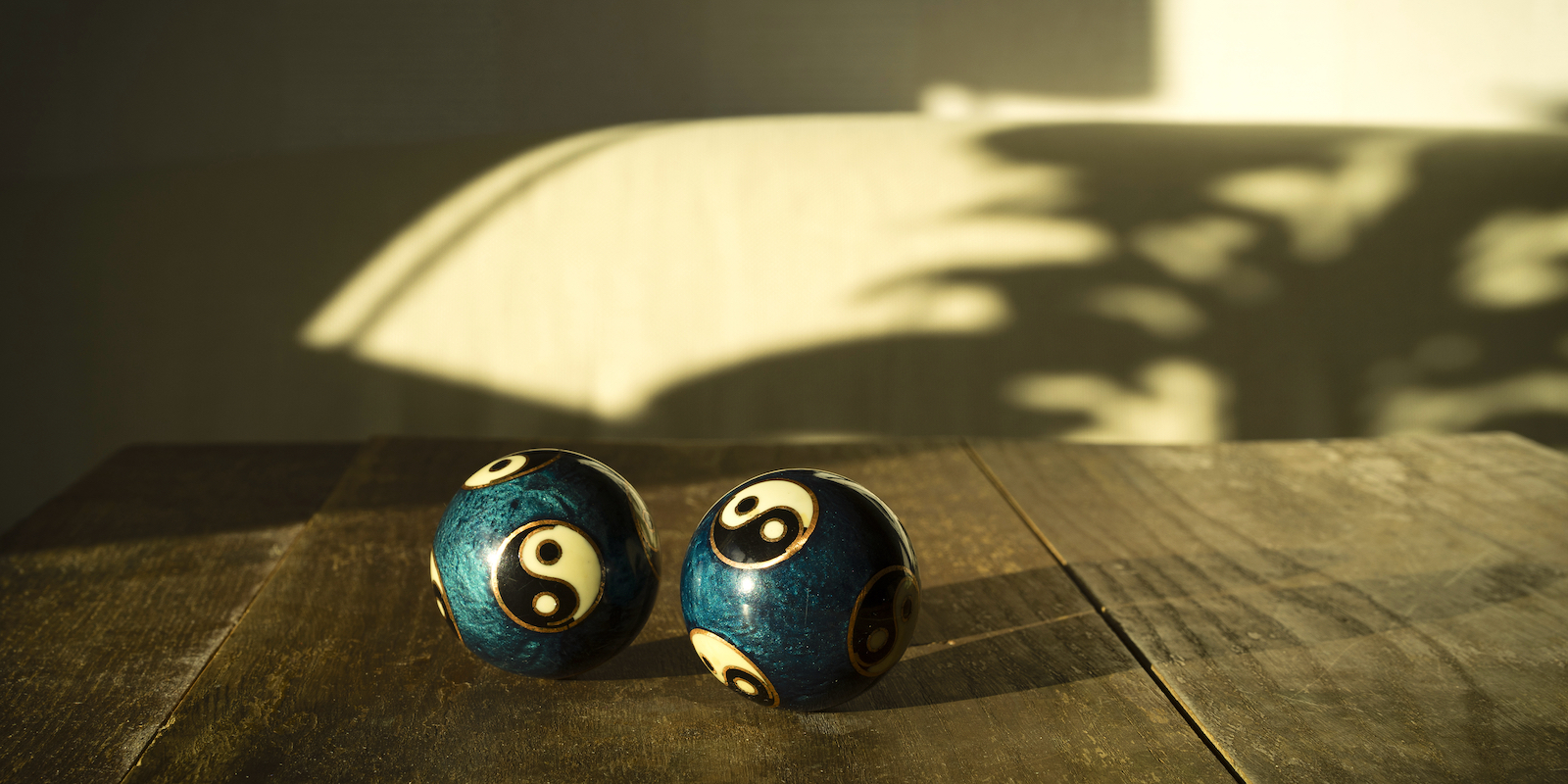Emperor Qianlong of the Qing Dynasty was said to have credited his longevity to daily Baoding ball practice. Looking at a pair of these unassuming metallic balls sitting neatly in a silk box, you may wonder just what’s so special about them, and whether their devotees are onto something. Whether they’re called Baoding balls, harmony balls, worry balls, therapy balls, medicine balls, relaxation balls or Chinese meditation balls, they’re a simple tool with a long history and an impressive range of benefits. Invented in the northern Chinese city of Baoding, Hebei, they purportedly relieve stress, focus the mind and build dexterity and strength in the arms and hands. If you’d like to learn a little more about Baoding balls and how to use them, this is the place to start.
Baoding Balls: An Ancient Tool For Health & Wellbeing
Baoding balls were first made thousands of years ago out of iron during the Ming Dynasty, and their use developed alongside the principles of Traditional Chinese Medicine (TCM). With a rich cultural history dating well before The Great Wall of China, it’s astonishing that Baoding balls are still popular today.
Read more: Explore the meanings of the metal element and water element in TCM.
Designs vary somewhat – some are lightweight and hollow, and contain a chime inside that rings when the balls are rotated in the hand, while others are solid and heavy. Though Baoding balls are still commonly made of iron, today modern versions can be made of jade, marble, semiprecious stones, metal, or wood. More functional pieces are crafted from smooth chrome or polished stone, while those intended for decoration are painted with beautiful Chinese symbols and pictures, intricately carved, or finished with embossed enamel and fine metal wire using an ancient technique called cloisonné. Baoding balls can range in size from 35 mm to 100 mm in diameter, depending on the strength of the user.
Historically, people of all classes and ages used Baoding balls, from emperors and soldiers to children and artisans. Originally, a pair of walnut shells was rolled in one hand to increase strength and dexterity but later, with advances in metalworking, specially designed iron balls were manufactured, and could even double as weapons. Often given as gifts to elders, some Baoding balls are not only functional but attractive enough to serve as art pieces in their own right, bringing a cleansing energy of harmony and wellbeing according to the ancient practice of Feng Shui.
The original principle behind their use has not changed for thousands of years, and Baoding balls are still relied on today for physical therapy of the hand, stress relief and relaxation. The simple, portable design builds hand strength through resistance training and trains the mind to use the hands with deftness and patience.
Benefits Of Baoding Balls
It’s a simple practice – one holds both balls in a single hand and carefully rotates them. Fine muscles and tendons in the hand come alive to carefully grip and manipulate the balls over one another, which stay in contact throughout. As the hand gains strength and the user becomes more adept, the balls can be rotated without touching one another, and manipulated in a variety of increasingly challenging ways. Depending on their desired effect, heavier or larger balls can be used, and some varieties even sport textures like ridges or ripples that add extra challenge.
While your hand muscles work, your brain is engaged, strengthening the mind-body connection and focusing awareness to tune out distractions. Though sometimes called “meditation balls,” these can seldom be used in formal sitting practice as they would be too distracting. However, using the balls can become a form of meditative practice in itself, stilling and centering the mind in a similar way to worry beads or a voiced mantra. Those with autism or ADHD can also use Baoding balls as “fidget toys” to support self-regulation and ease anxiety.
Even today, some Chinese doctors will prescribe practice with Baoding balls to boost flagging energy levels. In traditional Chinese medicine, life energy (Chi or Qi) flows through the body through channels called meridians. Via these meridian lines, the fingers are connected to the cranial nerves and all the vital organs of the body. Baoding balls are believed to stimulate acupressure points on the palm of the hand and restore the flow of Chi. Though practice with Baoding balls at first appears limited to the hands and fingers, the nimble rolling and rotating motions are understood to balance the flow of blood and vital energy along far-reaching meridian lines, benefiting the entire body.
Read more: In Hindu, Ayurvedic and Yogic traditions, Chi is often referred to as prana. Explore what prana is and how you can feel the life force.
Though the benefits of Baoding balls are largely anecdotal, many people claim a range of benefits including relaxed joints and muscles, better sleep, improved blood circulation, lower inflammation and even enhanced memory and intelligence. By rhythmically rolling the balls in the hand, the mind is calmed yet still alert. The hand is massaged and toned. If balls with an inner chime are used, a pleasing sound rings out as the uneven weight of each ball is shifted over the surface of the palm.
For most of us, we use our hands exclusively for small, repetitive deskwork tasks, never sparing a thought for the strength and health of our many delicate finger tendons and ligaments. Baoding balls can stretch and strengthen these muscles and increase blood circulation, soothing symptoms of carpal tunnel syndrome, arthritis and tendinitis. Whether you are a martial arts adept seeking to gain hand strength, a musician looking to improve dexterity or an athlete trying to recover from hand injury or weakness, Baoding balls are said to be an excellent way to improve coordination and muscle tone.
Read more: Learn how the benefits of stretching go beyond the physical side and become an emotional and spiritual practice on its own.
How To Use Them
Before you embark on a Baoding ball practice, it’s important to select a pair that match your skill level and the size of your hand. Choose a robust finish that will not be damaged with regular practice, like a polished chrome surface rather than one with ornate painting or engraving. Baoding ball sizes are given in millimeters: try 35 – 40 mm if you have a small hand or are a beginner, and a 40 – 50 mm pair if your hands are bigger. You should be able to comfortably balance one ball between your ring finger and little finger while holding the other with the remaining fingers and thumb.
The simplest motion to master first is to rotate the balls – push on both balls simultaneously to switch their position, so the ball nearest the pinkie moves up and over, and the other ball is pushed down and along the palm by the thumb. Spend some time getting familiar with the weight of the balls and the sensations against your palm as you experiment with different movements. It’s OK if the motion is inelegant at first, or if you drop the balls. Have patience and try again! With time, both the muscles in your hand and the neurons in your brain will fine tune themselves for increasing precision and control.
As the motion becomes smoother, you may like to increase the challenge by changing direction, or attempting to maintain a space between the balls throughout, so they no longer clink together. This requires greater concentration, more strength and a deeper stretch across the hand. Once you are comfortable with this, you can practice using heavier or bigger balls, or try a pair in a different material or texture for extra stimulation of acupressure points.
Your imagination is the limit: try cascading the balls one over the other, or even turn your hand palm down as you practice these same exercises. You could try moving faster without losing any grace or smoothness of movement, or practice with both hands simultaneously, coordinating movements left and right. Some people have even progressed to advanced practice with three or more balls, although this does take some dedication.
In the beginning, your practice will likely demand all your attention, but as you improve you can experiment with incorporating an element of mindfulness into your movement. In the same way as a mantra or bell can constantly bring your attention away from wandering thoughts and to the present, the repetitive movements of the balls in your hand can anchor you in the moment. Baoding ball practice can calm and steady the mind, allowing you to slow down and let go of anxious thoughts. Whichever way you use them, make sure they’re stored safely in their case when not in use. Certain finishes, like chrome, might benefit from a little polish or wax to prevent rust and enhance shine.
How To Shop Your First Pair Of Baoding Balls
Once you’ve determined what size works for your hand, decide whether you’d like a set with a chime inside. Usually, one ball has a higher tone (representing the Yang principle) and the other a lower tone (representing the Yin principle). If you want to use your Baoding balls on public transport, at work or during meditation, however, opt for balls without a chime.
Finally, the fun part is in choosing from the great variety of designs and materials. Choose something you really love, since you’ll be more inspired to practice regularly if you find your new Baoding balls beautiful to look at. Finally, it’s usually worth spending a little more on a quality pair that is smooth, as close to spherical as possible and sturdy enough for daily practice.
Balance the Yin and Yang parts of your self with these free guided meditations on Insight Timer:
- Balancing Yin & Yang: Bringing Harmony To Your Personality To Relax (Parts Work IFS) Emma Donovan 4:57
- Yin Yang Meditation Nathalie Maginot 19:29
- Yoga Nidra: Find Balance With Yin & Yang Nids Nidra 37:12







